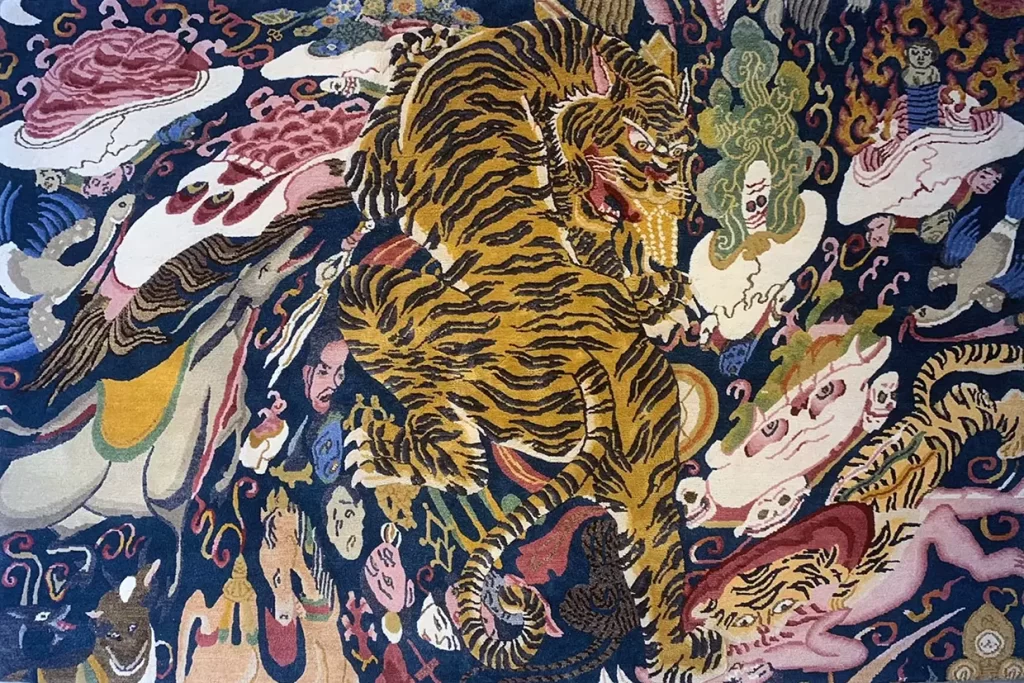
When two turbaned Samarkandis reached the borderland of the Middle Kingdom, they offered the Chenghua Emperor (r. 1464–87) a magnificent foreign beast, a lioness. The long journey across the Central Asia heartland had tired the animal; nevertheless, it appeared majestic. The court painter dutifully reproduced this scene. The resulting painting, The Lioness (1483), will be featured at Rossi & Rossi in From the Himalayas to the Heartland, on view from 24 September until 5 November 2022.
Over the painting is a fu, or prose, written by Chenghua, himself. The emperor was well versed in the art of poetry and calligraphy, and his fu speaks of this unique tribute, which was sent by Sultan Ahmed of Samarkand. It describes, at length, the mysterious and portentous animal of the distant western states and is signed with the sultan’s personal seal.
This event was documented in The Standard History of the Ming (Ming-Shih), under the section titled Samarkand, in the fourth chapter named Western Region. Such an offering illustrates the workings of the imperial Ming dynasty’s tribute system, in which a network of trade, ritualistic and diplomatic exchanges existed between the Emperor of China and the heads of state of various nations in Asia. The Ming emperor was recognised as the centre of power and representatives of other polities were required to journey to the Chinese capital periodically. They brought distinct treasures from their respective lands to present to the emperor as gestures of good will and solidarity.
Exhibited alongside The Lioness is a selection of precious objects from Mughal India, Nepal, Afghanistan, Bhutan and Tibet. Exquisitely fashioned, these works exemplify the artistic achievements and refined styles of craftsmen from the Himalayan region. Sword hilts, stucco heads of deities, pendants, lamps and more carry the ways of life, folk and religious, of those inhabiting both the Himalayan mountain ranges and the Indian subcontinent.
Amongst the highlights of the exhibition is an ornate ceremonial knife from nineteenth-century Bhutan. Decorated with Buddhist symbols, this dagger has a tapered, double-edged iron blade with double grooves. The gilt silver hilt is covered with a chiselled foliate decoration and turquoise inlay, whilst the cap-shaped pommel is embellished on the front with a pierced design of a parasol with two fish against a background of foliage. The parasol represents protection from harmful forces and the two fish symbolise the benefits of a state of fearlessness. The back of the pommel is chiselled with a honeycomb trellis resembling ancient armour designs.
The scabbard’s fine openwork parcel-gilt silver covering is decorated with Himalayan dragons and Buddhist symbols amidst densely entwined foliate work. The sheath is studded with small turquoise chips in box settings. A dagger of this quality almost certainly would have been made for a member of the Bhutanese nobility.
Today, artists from the region continue to work in innovative ways. Tsherin Sherpa (b. 1968), a Nepali artist of Tibetan descent, honours local artistic traditions of carpet-making by creating a series of carpets in collaboration with contemporary design studio Mt. Refuge. Fabricated from highland Tibetan wool and Chinese silk, his textiles derive inspiration from folklore, religious tales and cultural symbols of the Tibetan plateau. The resulting works reflect Sherpa’s approach to contemporary art, one in which tradition and modernity are in constant negotiation.
From the Himalayas to the Heartland
24 September – 5 November 2022
Rossi & Rossi Wong Chuk Hang














